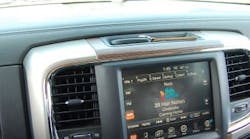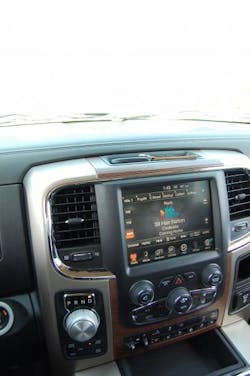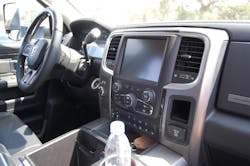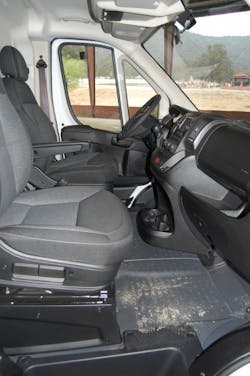Now, sure, these may be minor quibbles where the interior ergonomics of vehicles are concerned, but frankly they tend to drive me bonkers.
Not that either shift knobs – technically known as a “rotary shift dials” that Ram decided to use when it rolled out its new TorqueFlite eight-speed transmission last year – or push button start systems fail to work well.
Indeed, I encountered both in several Ram Truck pickup models I tested last week just outside Thousand Oaks, CA, on a Ram 1500, 2500 and 3500 pickup and no hiccups occurred due to them.
But I also tested a Ram 2500 HD pickup (a bi-fuel model capable of running on natural gas no less) as well as Ram’s new ProMaster full-size van, and both of them featured “traditional” stalk-style shifters mounted on the steering column, as well as key-in-the-ignition starters. And maybe it’s just me, but I felt far more comfortable with such “old style” accoutrements.
Maybe it’s a comfort thing, in a way, for having a steering-column-mounted stalk lever-style shifter helps me adjust to new vehicles faster.
The same holds true for the old “key-in-the-ignition” system, but in this case, there’s an added worry as you need to keep an electronic “key” inside the vehicle to authorize the push button start system to fire up the engine. Yet having a “key” wandering around “loose” in a truck – indeed, any vehicle – is in my estimation just asking for trouble.Then again, as Ram – like other pickup truck OEMs – keeps improving their models to boost fuel economy, payload, performance, etc., design changes need to be made.
Let’s go back to the “rotary shift dial” for a minute. In Ram’s case, when it decided to add an eight-speed transmission for the 2013 model year, that required the OEM to replace its traditional floor-mounted center console “gate shifter” in order to preserve cab space.
While Ram readily admitted that adding a shift knob is “a dramatic change” in the way trucks have historically shifted gears, its interior design team tried to make the knob as intuitive a feature as possible.
Prominently placed to the driver’s right, at the lower left-hand side of the center stack, in place of the previous transfer case shift knob, the new rotary dial locates “Park” at the furthest left, while turning clockwise hits “Reverse,” “Neutral” and then “Drive” at the furthest right. This new design allows for quick and easy shifting for operators wearing gloves and for blind-shift transitions between “Drive” and “Reverse,” Ram said.That’s all true, as I conducted said shifting quite easily with said knob. Also, this new shift “knob” feature can be applied to both bench and bucket seating configurations, Ram noted, so operators get to spec the best interior cab layout to meet their needs. Indeed, the OEM noted when it first introduce the “knob” for the 2013 Ram 1500 pickup, with the console shifter out of the way, trucks spec’d with bucket seats offer additional storage capacity in place of a the floor-mounted shifter.
Ram also added that the transfer case retains full capability with light emitting diode or LED lights used to highlight “4WD Auto,” “4WD Lock,” “4WD Low,” “2WD” and “Neutral” push buttons located directly under the e-shift knob.
The push button start feature also adds some new capability for truck owners, too, especially “remote start” to help warm up or cool down equipment before driver and crew get in at either the beginning or end of a long workday. That’s not too shabby a feature to have handy, when you think of it.
Still, commercial customers (in at least my humble experience) tend to be conservative and often take a “if it ain’t broke don’t fix it” attitude when it comes to replacing traditional components with “newfangled” gizmos. Yet it is often those very “newfangled” designs and systems that make work trucks a lot more efficient to operate over time.
We’ll see if the rotary shift knob and push button start make that connection long term in the commercial truck world.






